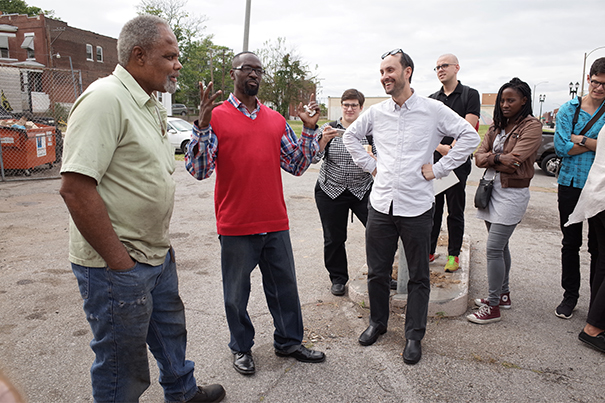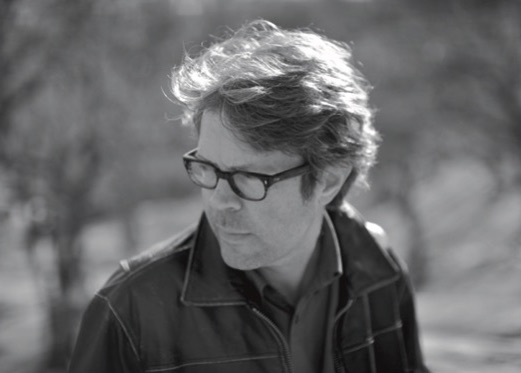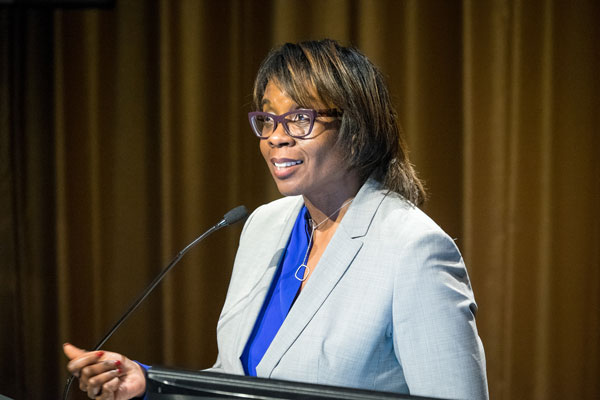Jonathan Franzen and GSD Converge on St. Louis and the Urban Condition
The Harvard University Graduate School of Design (GSD) has engaged with the city of St. Louis from various approaches over the past few years—an illustration of the School’s broader commitment to tackling the challenges facing America’s cities.
American cities provide a complex backdrop to our twenty-first-century lives. When award-winning novelist Jonathan Franzen comes to campus to present as part of the Rouse Visiting Artist Lecture series on April 18, he will likely reflect upon the context of St. Louis, his native home, and the city that serves as the setting for his first novel, The Twenty-Seventh City (1988). (“It’s all there,” wrote Newsweek, “in Jonathan Franzen’s first novel: racial unease, suburban malaise, a St. Louis hopeful and weary…”) As a native of Webster Groves, a cocooned suburb about fifteen miles south of Ferguson, Franzen has reached beyond his protective enclave to examine the social and political forces at work in the 100 separate municipalities that define this urban metropolis. For GSD students who have been working in St. Louis, his insights on the city will likely be especially poignant.
St. Louis has provided a vibrant laboratory for multiyear, multi-disciplinary urban research. By collaborating with local experts through options studios and multi-year design research projects, the School hopes to inspire projective thinking that promotes productive change.
Last March, the GSD and the Sam Fox School of Design & Visual Arts, with support from the Faculty of Arts and Sciences and Center for the Humanities at Washington University in St. Louis, jointly mounted the GSD conference Voices and Visions of St. Louis: Past, Present, Future, organized by Diane E. Davis, Charles Dyer Norton Professor of Regional Planning and Urbanism and Chair of the Department of Urban Planning and Design.
In some ways, the story of St. Louis is the story of America, and the city offers a lens for unpacking dynamics at play in many American cities
~ Diane E. Davis

Voices and Visions of St. Louis: Past, Present, Future, organized by Diane E. Davis, Charles Dyer Norton Professor of Regional Planning and Urbanism and Chair of the Department of Urban Planning and Design.“
“In some ways, the story of St. Louis is the story of America, and the city offers a lens for unpacking dynamics at play in many American cities,” notes Davis, a St. Louis native, who is hosting the Franzen lecture. “Issues of injustice, inequality, and racial exclusion, while certainly not unique to St. Louis, have played a highly legible and powerful role in shaping the city we see today. This offers students and faculty the opportunity to develop a rich understanding of these issues, and to deploy that sensibility through their work in St. Louis.”
The School’s work in St. Louis has served as inspiration for Dean Mohsen Mostafavi’s vision for the Future of the American City, a new initiative with targeted projects in Boston, Detroit, Los Angeles, and Miami. Building on the strong body of groundbreaking work already underway in cities like St. Louis, the initiative is extending the discourse on issues affecting urban environments in the United States with the objective of creating actionable proposals. Dean Mostafavi asserts, “The unprecedented scale of challenges facing our cities around the globe requires design leadership, innovation, and societal engagement like never before. As the GSD gleans experience and insights from studying urban regions around the globe, we are committed to re-establishing our influence on cities in the U.S., in all their forms, through our Future of the American City initiative.”

Associate Professor of Practice in Urban Planning Daniel D’Oca MUP ’02 during the studio Affirmatively Further: Fair Housing After Ferguson.
Voices and Visions was just one piece of a broader web of St. Louis-based research projects underway. Associate Professor of Practice in Urban Planning Daniel D’Oca MUP ’02 has led two consecutive, interdisciplinary options studios on social justice in St. Louis–The MLK Way: Building on Black America’s Main Street and Affirmatively Further: Fair Housing After Ferguson (Fall 2015 and 2016). D’Oca sees the benefits of prolonged engagement, “When working on complicated, contentious urban issues from afar, it is understandably difficult to build trust and working in the same city for multiple years offers an opportunity to foster it. Harvard is a great brand, obviously, and while I have found that community-based groups that we worked with are typically happy to be working with Harvard students, forming trust–and subsequently leveraging it to built relationships–takes time.”
Working with local communities groups, including Forward Through Ferguson and Metropolitan St. Louis Equal Housing, these option studios challenged students to think boldly about how architecture, landscape architecture, urban planning, and urban design can help affirmatively further fair housing. To conduct their research, students traveled to St. Louis to analyze and map housing patterns in the St. Louis region and created speculative proposals that are both site specific and scalable.
The experience was revelatory for Mexico native Ruben Segovia MArch ’17. “I was quite shocked by the poverty–it is different than what you see in Latin America. In St. Louis, there is infrastructure, but it is decaying and the conditions are harsher than I anticipated. The studio experience, including collaborating with local NGO’s and community groups, was profound, inspiring me to develop a website and book to educate the local youth about the complex and dynamic historical context–including redlining–that underlie their current condition.” While student proposals ranged dramatically, the School’s ambition is to convene experts in discourse and to inspire local housing advocates, activists and the community with an influx of fresh ideas that resonate.
GSD students and faculty are also building upon the momentum from these events, through individual research projects that expand on the critical conversations and partnerships they initiated. Several student-led research projects focused on St. Louis are underway: Map the Gap is a speculative student research project that considers St. Louis through a comparative lens; and Designing Justice, which held a symposium in conjunction with Voices and Visions, highlights and promotes cross-disciplinary design research about justice and equality—and, injustice and inequality—around the world.
Adjunct Professor of the History and Theory of Urban Form and Design Eve Blau partnered with Heather Woofter and Michael Allen for a seminar entitled Citizen Space: The Political Underpinnings of Cities and Social Spaces Affected by Government Infrastructures, which explored the role of government influence on public space in St. Louis through history, considering the topic of government investment (and disinvestment) through the National Geospatial Intelligence Agency project and the adjacent Pruitt-Igoe housing project site.
Professor in Practice of Urban Planning Toni L. Griffin LF ’98 led There Goes the Neighborhood: Perceptions and Realities of Neighborhoods and Neighborhood Change, a seminar about neighborhood change in American cities. Though not specifically tied to the St. Louis context, this seminar pushed forward critical conversations about the role and goals of designers in shaping the future of justice and equity in American cities like St. Louis.
While Davis does not want to overstate the School’s immediate impact in St. Louis, she is confident that this work makes a difference to the community. “We hope that we can serve as allies for St. Louisians working to build a more just, more inclusive city, and to help build momentum behind their efforts. By offering outside-of-the-box thinking and by asking questions in new ways, where possible, we hope to help people think about issues they confront every day from a fresh perspective.” As the Future of the American City takes seed, the GSD anticipates that Boston, Detroit, Los Angeles, and Miami will provide equally compelling case studies that result in actionable proposals.
As students respond to the ever-evolving dynamics at play in American cities to champion the role of design in building more equitable and just cities, they will no doubt find inspiration in the depth, creativity, and fluidity that a writer as skilled as Franzen brings to his framing of the urban condition. While he has spent the better part of his career exploring the urban context, his focus has recently shifted to include broader themes quite familiar to GSD students–the role of nature and the impact of climate change. The relationship between man and his environment–the human condition–is the constant that informs our two creative endeavors.


